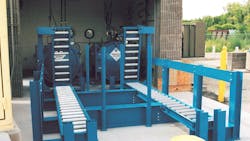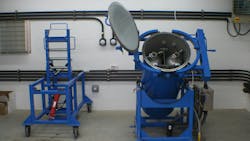Secondary containment vessels for El Paso improve chlorine safety
The capital projects manager for the City of El Paso, Texas has deployed special secondary containment vessels for chlorine gas.
Vessel safety
The containment vessels will serve as a readily accomplished safety enhancement for employees and the public they serve. They will be used in the extensive network of treatment plants and booster stations across Texas’ water utilities.
Warren Marquette, P.E. and capital projects manager has seen cylinder containments used in other cities as well as El Paso, as well as the safety of the systems during chlorine dosing, highlighting their reliability and the difference they provide.
“We have had no incidents of chlorine gas exposure for our workers or surrounding communities,” said Marquette. “Our facilities are right up against our population in many locations, and we’ve conducted simulated plume escape studies as part of our hazard operations program."
Maquette, who’s experience with chlorine dates back 25 years, said his first installation was in 2002, when he served as a consultant to the utility at a booster station.
“We’ve since expanded deployment considerably, including after I became an employee in 2015, first as utility engineer, and a year later as capital projects manager," Marquette said. "We now have them installed at numerous other booster stations, as well as at two of our wastewater treatments plants (WWTPs), and a blended desalination/well water drinking water treatment plant (WTP).”
Secondary containment technologies
Marquette stated that pressurized chlorine systems were impractical at other plants due to available footprints and the consumption rate of the plants.
As facilities are built out Marquette foresees the opportunity for more secondary containment technologies to be utilized. These technologies could become common place in the advanced water treatment and direct potable reuse plants currently in the design phase.
“We’ve been using this technology for over 20 years now, including many units," Marquette said. "From the start, they’ve gone incredibly smoothly, including the commissioning, especially compared to other systems we’ve put in. We dose by weight, and the units come with a built-in weigh scale, as well as nitrogen fail-safe isolation valve, weight indication, safety valve, regulator connection; everything well packaged, for simple, seamless integration into our SCADA system; basically plug and play.”
Deployed technology
The special secondary containment vessels for chlorine gas cylinders are currently in use at three plant locations. The vessels, manufactured by ChlorTainer/TGO Technologies Inc. of Santa Rosa, California, are featured at a 17.5 MGD WWTP, 12.5 MGD WWTP and a 27 MGD WTP where chlorine is dosed into reclaimed water at the clearwell and again at discharge pipes.
The vessels are also in use at numerous booster stations where chlorine is further added to maintain free chlorine residuals as regulated throughout the distribution system.
“We dose chlorine into the discharge of the booster stations using a quill injector fitting,” Marquette said. “In the plants, we’re dosing into whatever clearwell we have, and then again at discharge. For the booster stations, we’ll typically have an electrical room, a pump room, and a separate room for the ChlorTainers; two 1-ton units, with drawbridge loading, side by side. Chlorine solution is injected to the pump station distribution discharge to maintain chlorine residual.”
Marquette stated that a process to switch cylinders is in place that takes at most 15 to 20 minutes. Delivery trucks bring in the cylinders which are placed on a roller conveyor. The empty container is then removed and the new one is put in its place.
Employees were easily trained on the process according to Marquette.
Installation
Marquette stated that when it comes to installation, they haven’t had any issues with contractors, and that installation of the vessels has gone smoothly.
The installation contractor for the El Paso Water Utilities site is Smithco Construction Inc., who serves the whole state and parts of Arizona and West Texas.
Robby Sanders, a Smithco project manager, stated that the installations have been straightforward.
“We installed a 1-ton ChlorTainer as part of a booster station for El Paso drinking water that was completed in 2019," said Sanders. "Commissioning was then delayed due to Covid, but we expect that to be completed soon. We put it in the utility’s own concrete black (CMU) building that we built for that project. Due to the delay between installation and commissioning, we will probably have to revisit the warranty situation, but I have no concern about that.”
Smithco Construction has also been awarded contracts with the utility’s airport and the Ranchos Real booster stations to install ChlorTainer units.
Sanders first installed a unit in 2018 in Carlsbad, New Mexico, which gave him useful experience on the product. “I knew about the product from one of our other project managers who had already done similar work in El Paso," Sander said. "Our scope of service in Carlsbad also included installation of 20,127 linear feet of 24-inch waterline; 9,650 linear feet of 16-inch waterline; and supervising a subcontractor for a 5 million gallon concrete pre-stressed water reservoir.”
Sanders said that installation has been seamless. Communication with field crews has been effortless, and deliveries were on time and the instructions for installation were clear.
"Compared to other kinds of equipment, this one is more detailed, but it’s been easy to get approved, by the second time around; we get it released, and fabricate right away," Sanders said. "That’s not always the case with water plant equipment. The vendor has been very responsive to any question or comments; they get back to us right away.”
Submittal reviews are said to be complex, but have been easy to get approved with the firm, vendor and the utility’s consulting engineer.
Proper maintenance of the vessels include changing out the Viton O-ring on the door, which takes about 30 minutes. With good maintenance, the vessels’ life expectancy is said to be no less than 100 years.
The secondary containment vessels are ASME-rated pressure tanks, and any leaky are recycled inside the injection system at a normal flow rate. A failsafe valve ties into the chlorine leak detection sensor so that in the event of an external issue, the nitrogen failsafe will close—stopping it completely.
The article referenced in this story originally ran as El Paso enhances safety with chlorine gas cylinders on Wastewater Digest, and Endeavor Business Media partner site.


